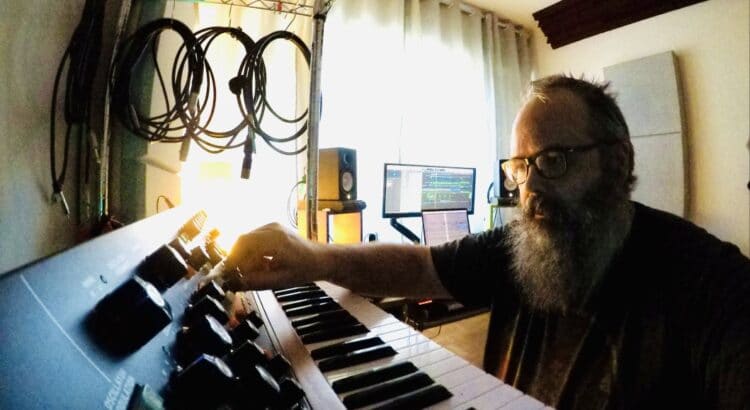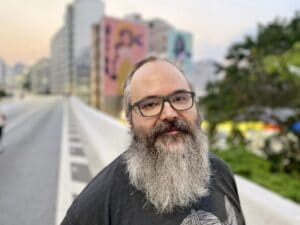 For many years, Felipe Adorno Vassao has been one of our stalwarts of production music here at Shockwave-Sound.com, having composed (at the time of writing) 277 royalty-free music tracks of incredible quality, diversity, and attention to detail. Felipe is one of those guys who can nail any sound and has an incredible knack for coming up with grooves and sounds that just work so well with music for media, be it film, television, gaming, commercials or other projects — so many people have had their project lifted to a whole new level with his music.
For many years, Felipe Adorno Vassao has been one of our stalwarts of production music here at Shockwave-Sound.com, having composed (at the time of writing) 277 royalty-free music tracks of incredible quality, diversity, and attention to detail. Felipe is one of those guys who can nail any sound and has an incredible knack for coming up with grooves and sounds that just work so well with music for media, be it film, television, gaming, commercials or other projects — so many people have had their project lifted to a whole new level with his music.
Felipe Vassao lives and works in Sao Paulo, Brazil, where he picks up local as well as global trends and isn’t shy to try them out in his productions. We conducted an in-depth interview with Felipe for your reading pleasure and hope you’ll enjoy this special insight into the life and work of a master stock music composer.
Felipe, can you tell me a bit about your background as a musician; how did you get started in the music industry and what were your first paid jobs?
“I had some piano lessons when I was a child and later on, around 12, I started messing around with a guitar we had lying around at home. I got into rock and heavy metal and started learning by ear and reading some chords, later on some TABs, getting into shedder territory: Steve Vai, Van Halen, Satriani etc.
When I was in high school we were putting together a school play and I was selected to be in charge of the music. That was my first experience writing arrangements and I loved it.
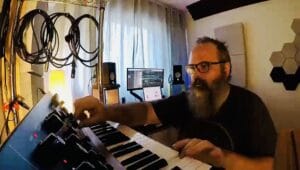
In my senior year, I had to produce and record some instrumental cues for that year’s play and a friend took me to a studio he was working as an intern. The studio owner liked what I was doing and invited me to do some soundtracks, so I started getting some advertising gigs even before graduating from high school.
My first paid job was some soundtrack for some advertising – I don’t remember exactly – but shortly after I was spending all my free time in the studio.
I got into music college in São Paulo (UNESP) but as time went by I started to be ”dragged into” the advertising and soundtrack world, so I eventually dropped college after four years to focus on my career.”
I understand you started «Tempero Music Production» a while back – when was this, and what’s the story behind it? Are you running that company all by yourself, or do you have colleagues in the company?
”Tempero” was an initiative started in the early to mid 2000s to write production music aimed outside the Brazilian market. I had been doing a lot of advertising music and soundtrack in Brazil since the early 1990s, and had some unused music lying around, so I thought it would be a nice way to branch out and put that idle catalog to make some money.
For a while, my then-wife wrote some tunes, but since 2012 I have run it all by myself. And basically write music exclusively for Shockwave-Sound.”
Related: Royalty-Free music tracks like the “Kung Fury” soundtrack
Can you remember how and when you first heard about Shockwave-Sound and what made you want to get in touch and offer your music to us?
“Sometimes a client contacted us to write original music, but with a limited budget, so we offer to find, edit and adapt library music instead. That way we can fit the budget but still have some degree of coherence and artistic criteria.
On one of these assignments back in 2006 I came across Shockwave-Sound and loved the music available. It was an epic soundtrack by Pierre Langer. I immediately thought it would be a good place to have my music featured.
I noticed it had very few Latin tracks and almost no Brazilian production music, so I started by offering these genres.”
It’s obvious from the range of styles and sounds in your musical creations, that you are a versatile and multi-talented composer and producer. What’s the secret of «mastering all styles» in the way that you do? Any tips or guidance from you, for young musicians starting out, who want to try to achieve such versatility of all styles and genres?
“Thanks! I believe it’s all about respect, practice, and fun.
Respect for the culture and work of others helps you to put yourself in their shoes and try to understand their path to achieve that sound.
And after analyzing and listening a lot, it is time to give it a shot and make it your own. But practice and repetition go a long way.
In the late 90s I got a gig for a Karaoke DVD company, in which we had to recreate a lot of popular music pretty similar to the originals, in audio format (not MIDI files), so we had to record and produce it as a regular record.
This gig really helped me hone my skills into diverse genres, and made me a better listener as well.
And I just love to try out new styles, almost as a ”workout” or a challenge, so if some new trend comes up I always try to write in that genre.”
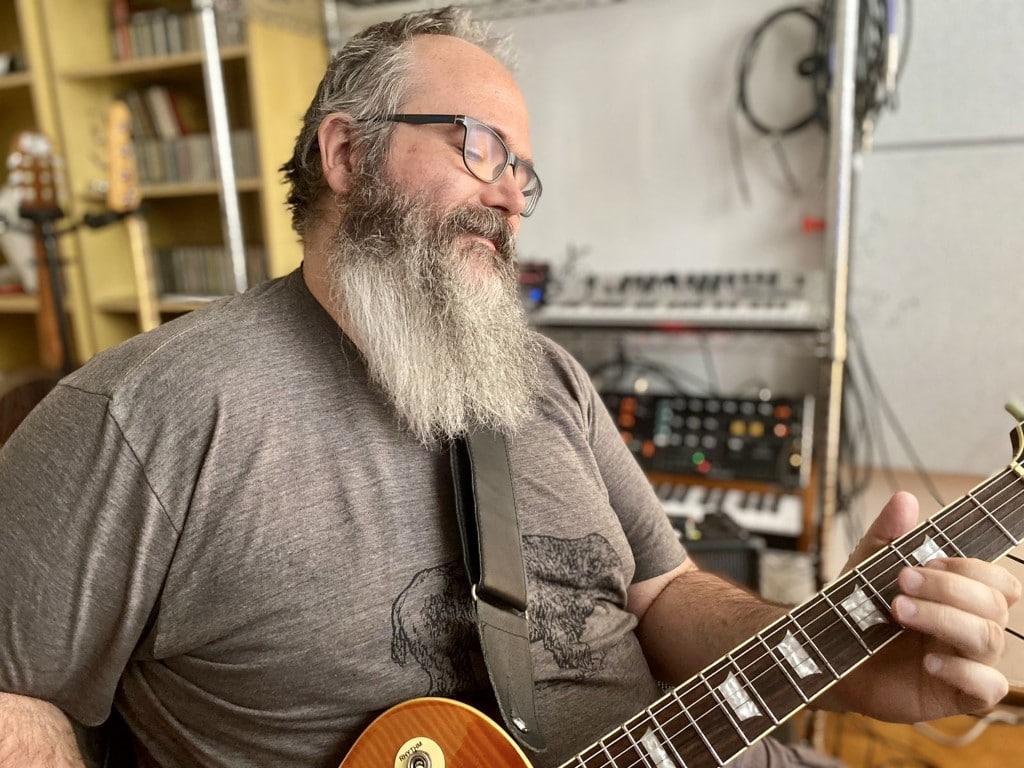
I’ve also noticed that you have a talent and a knack for creating nostalgic, retro-sounding music – those lovely 1950’s and 1960’s sounding tracks that sound so authentic. How did you get into that, and why?
“Growing up watching lots of North-American sitcoms, as a lot of people worldwide, I was crazy about the theme songs – from the 50s to 80s – but these 50s and 60s have a special place in my heart due to Ren & Stimpy, a 90s’ cartoon that used a lot of retro library music to create a stylistic dissonance with the overall non-sense of the series.
I also love Henry Mancini’s songs and arrangements, so writing these tunes is a way to connect with all these passions. And also sometimes I get inspired by a preset on a sampler, or by a retro sound that I got from my guitar amp, and develop from there.”
Related: Gangster Flick, Vol. 1
Do you ever use «unconventional» ideas or come up with some music or recordings in unusual, fun ways? Any examples of this?
“Sure! Sometimes I’m editing something and get stuck in a glitchy loop. If that catches my ear I bounce it and develop something from there. That was how ”Tiny Bits” started.
In advertising we get a lot of requests to be bold and crazy, so sometimes we try some wild things, like producing a food jingle using only its packaging for sounds and samples.
In other cases I can think of a cool guitar solo in my head and instead of practicing and recording it with the instrument, I sing it into autotune and an overdriven amp, and it really sounds like a crazy guitar, but with a unique quirk.”
We may have some readers from Brazil who may have heard your music in some famous or well-known TV commercials?
“Oh, I believe so! Since 2005 I’m the founder and partner of a Brazilian music production studio aimed for advertising called LOUD+.
We’ve done campaigns for almost all major Brazilian advertisers, from telecoms Vivo, Claro and Oi, to car manufactures GM, Ford, VW etc, to beauty (Dove, Natura, Avon etc) to the food industry.
The list is extensive, so you can check out some selected works here: https://loud.bz/publicidade/
On the other hand, I’ve been producing some singles and albums for artists since late 1990s, and have been collaborating with Emicida, a huge name in Brazilian urban music, since 2007.
Last year his latest album ”AmarElo” won a Latin Grammy award, in which I co-wrote and produced the title track.”
Wow, I didn’t know you had also worked on such high-profile, mainstream music releases. In a few words, who is Emicida, and what is his style and sound?
“Emicida is a Brazilian rapper, with whom I’ve been fortunate enough to be collaborating since his debut back in mid-2000s. His take on rap is very unique, bringing a lot of our Brazilian heritage to the music, and expanding into fashion, TV, visuals etc. always connecting his narratives with the enslaved African legacy and its consequences.”
What is the main software you use for recording and mixing your music?
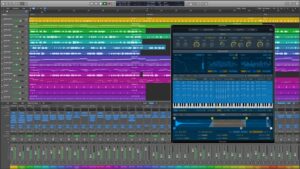 “I’ve been using Logic to produce since it was called ”Notator Logic” running on an Atari desktop computer (i’m old… heheh). But I’ve been producing some stuff on Ableton Live since 2018 and I’m loving it. So right now I’m between the two. But Pro Tools is still my favorite software for mixing.”
“I’ve been using Logic to produce since it was called ”Notator Logic” running on an Atari desktop computer (i’m old… heheh). But I’ve been producing some stuff on Ableton Live since 2018 and I’m loving it. So right now I’m between the two. But Pro Tools is still my favorite software for mixing.”
I know what you mean; I’ve been using «SONAR» since back in the time it was called «Cakewalk» (I’m old, too! hehe). What would you say is the main difference in the process and approach, between working with Logic and with Ableton Live? What makes the process different?
I tend to use Logic for more ”human” music – orchestral, jazzy etc – stuff that has to sound kinda ”live”, mainly because its MIDI Transform functions are super good, and I do use a lot of ”humanize” to bring some sauce to stiff MIDI tracks.
On the other hand Ableton Live’s warp is just amazingly easy to mess around with, and super stable. Not to mention that I believe it sounds better for EDM and general Pop music.
I don’t know if it’s the sound engine, the factory compressors and reverbs, but when I start a Trap or a House beat on Logic it lacks a ”beef” that I can easily achieve on Ableton Live.
In a nutshell: If I’m starting a tune on a piano, guitar or orchestra, I’ll probably go for Logic. If it’s ”beat/sample oriented” I’ll reach out to Ableton Live.
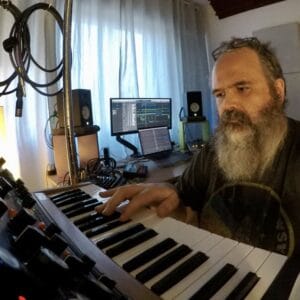
Below is a playlist of only a few of Felipe’s great royalty-free music tracks that he’s composed and produced for us here at Shockwave-Sound.com. Enjoy!
